She feels really easy and comfortable to sail, even in a good breeze and a chop.
- Fuss-free, comfortable cruising
- Respectable fuel efficiency
- Versatile accommodation options
- Glorious views from flybridge
- Lots of storage
- Traditional styling
Beneteau goes back to its roots with this trawler-style launch, but the Swift Trawler 44 is far from being a traditional fishing boat.
Many Kiwis associate a Beneteau with the company’s well-known range of production yachts but, in fact, the
French manufacturer’s roots lie in producing working fishing boats, right back to the 1880s. This latest model in the Swift Trawler range certainly works as a ‘fishing boat’, but is more of a platform for very comfortable cruising.
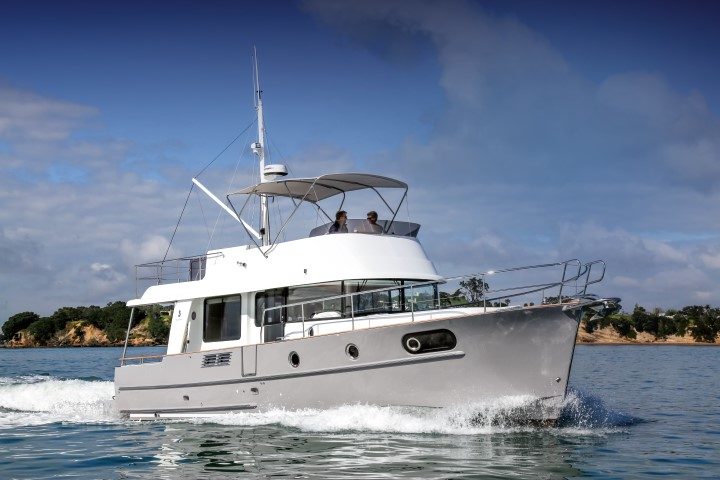
This boat, called Kingfisher in ironic reference to its owners’ lack of success with the rod, is one of two Swift Trawler 44s heading out on to the Hauraki Gulf this summer. She’s powered by a traditional arrangement: a pair of Volvo D4-300 diesels paired with shaft drives, with bow and stern thrusters. Conrad Gair of Beneteau agent 36 Degrees Brokers says while many owners today are going for an IPS ‘pod’ drive system, this boat’s owners wanted the simplicity, lower cost and lower maintenance of shaft drives.
The Swift has a classic trawler look, with a high, shiplike bow, a walkaround enclosed by bulwarks, and a large flybridge which effectively forms a second area of living space.
Below the water, the semi-displacement hull (by the late French naval architect Michel Joubert) has a deep vee and a large chine with two spray rails beneath it, making for a smooth and solid ride. The high topsides are broken up by a belting which runs along much of the length of the hull, below the portholes in the lower accommodation.
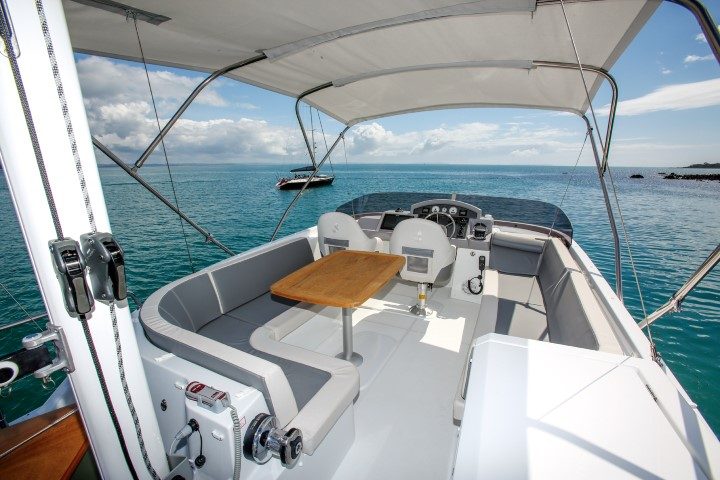
For its new owners, a big selling point was the large area on the upper deck which could accommodate their Zephyr sailing dinghy. The owners are sailors at heart, and like to be able to drop the dinghy in the water (using the electric boom) to go for a sail when out cruising around the Hauraki Gulf or Bay of Islands.
The owners want to use the boat for extended cruises of up to six weeks at a time, as well as weekend getaways. That means they need plenty of storage, and the ability to be largely self-sufficient for long periods of time. The Swift Trawler offers economic, long-range cruising, and could even cruise as far as the Pacific Islands, with the fuel capacity to cover around 1,000 miles at 8 knots.
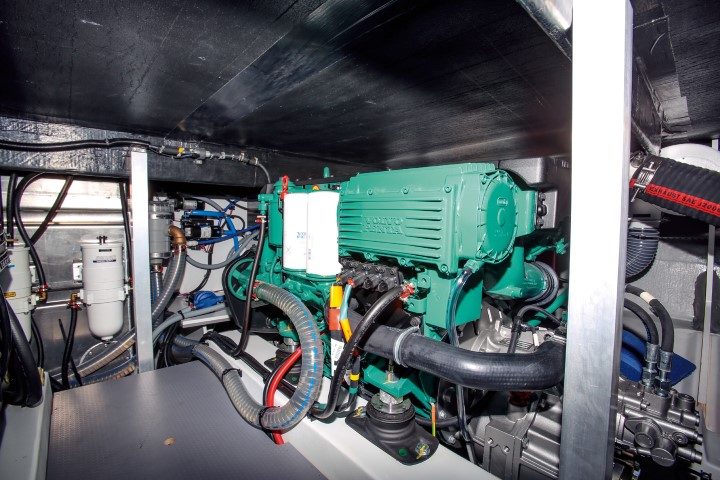
It’s not all lazy cruising, though – this boat can certainly get up and go if needed. As you might expect from the name, the Swift Trawler’s no slug. It has a top speed of around 24 knots, but cruises comfortably at around 18 knots, using around 60-65 litres of fuel per hour, depending on sea state. For longer range cruising in good weather, the owners are happy to stick to around 7.5 knots, which reduces fuel usage to around 8-10 litres per hour.
ON BOARD
The Swift Trawler comes in both white and navy, but these owners opted for Beneteau’s ‘grey perle’ hull, a pale charcoal. It is both practical – it won’t get too hot in the summer sun – and slimming. Timber handrails and other detailing soften the all-white look of the cockpit.
Coming aboard, there is a large, teak-finished boarding platform aft, out of which telescopes a large, integrated boarding ladder. There are two large storage lockers within the platform, one of them a draining wet locker.
The cockpit is fully-enclosed, accessed by a door in the centre of the transom. There is an L-shaped seating area to port, and the entire cockpit area is sheltered by the top deck. This space can be totally-enclosed with a set of clears, effectively creating an outdoor ‘room’ suitable for use in all weather.

Under the cockpit floor is a large water tank. But at the back of where the second tank would usually be fitted, these owners have opted to install a CJD water maker, to make themselves self-sufficient for longer periods. It also means they can rinse off dive gear and other equipment without worrying about wasting precious resources, and share water with other cruising friends. There is also a 9.5kVA generator and 2kW inverter down here.
To starboard, a generous set of stairs leads up to the flybridge – where the owner’s immaculate Zephyr dinghy is stored. This space is also plenty big enough for stashing a tender, or for use as a barbecue area.
Forward of the ‘dinghy locker’ is the flybridge helm station, equipped with a Raymarine chartplotter and a second set of instruments and engine controls. This is the owners’ preferred helming position, and you can see why, with excellent visibility and shelter from the sun provided by a canvas soft-top. They’re hoping it’s going to be a good spot for dolphin- and whale-watching.
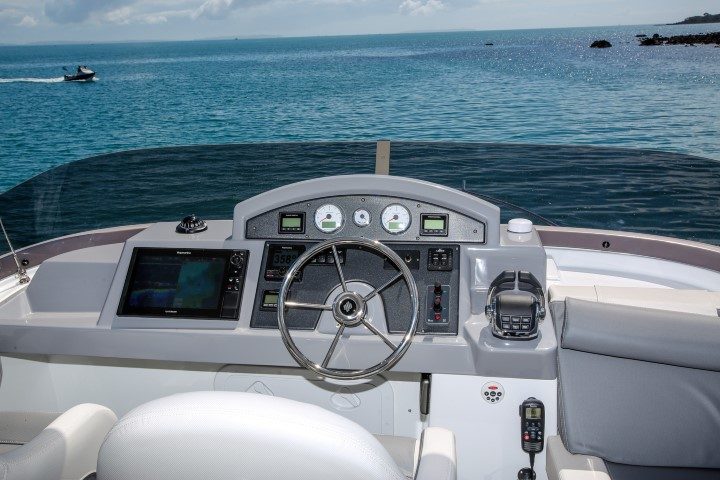
There is also plenty of seating for relaxing and entertaining up here, as well as a sink and storage space if you’re making a day of it and don’t want to go back down below for supplies. While the owners’ previous boat was a sedan-style launch with a large cockpit, they say this entertaining area upstairs, with its ample seating and great views, is just as good if not better.
Back down at deck level, there is a walkaround either side, although it is wider on the starboard ‘driver’s’ side, and covered as far as the helm station, for easy access to the bow. Up here there is a large lounging space, as well as the anchor-chain locker and remote-controlled electric windlass for the anchor, sitting on its sprit. While she is quite a big boat, the owners say she is easy to anchor and dock, even short-handed.
From the cockpit, the saloon is accessed through a large sliding door. To starboard is a large, white leather settee, with an extendable table in the centre. To port is a panel of slimline storage cabinets, leaving plenty of room to move forward to the galley and lower helm station.
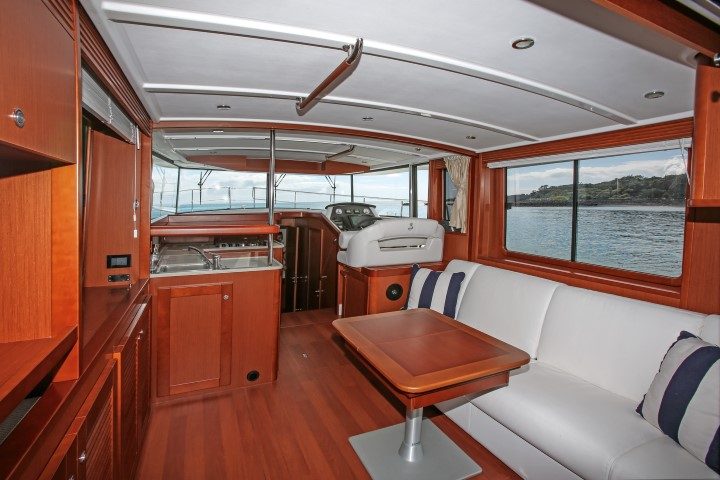
This saloon area can be partitioned off from the galley and helm station with a curtain. The large settee folds out to convert into a full-size double berth, so this area is effectively another cabin, rather than just a place where two more people could sleep if they really had to. Large rectangular windows with venetian blinds make this look more like a room than the inside of a boat, although the owners have opted for a parquet-type floor for a nautical feel.
The galley is U-shaped, with twin sinks, an underbench oven in the centre, and a three-burner gas hob on the forward side of the U. There is an under-bench fridge under the helm seat to starboard, and a toploading icebox in the forward corner of the bench. The cabinetry is classic mahogany, with the flecked Corian benchtop providing a modern touch.
To starboard, the large white leather helm seat can fold forward to create extra table-top space if required. Its raised position provides good visibility forward and to the sides, and the walkaround can be accessed directly out of a sliding door.
There’s a very large yacht-style wheel with a leather cover, a Raymarine 12-inch chartplotter, instruments, the push-button start and throttle controls for the Volvos and thrusters, and the controls for the autopilot. The owners say while
steering from upstairs has been their default so far, when the weather isn’t so great this helm station also offers good visibility and a lot more shelter.
Heading into the accommodation area, down a pair of neatly-angled steps, the master cabin is straight ahead, in the bow. A large mirror on the forward bulkhead contributes to the feeling of space, as do two, long through-hull windows with opening ports, and the foredeck hatch above – and the 1.92m headroom. The slat base to the bed is a nice touch, as is the massive storage space underneath it which is easily-accessed by lifting the mattress.
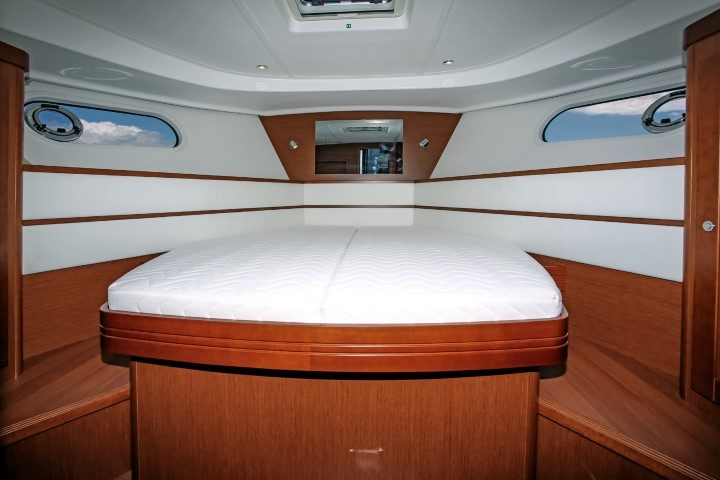
There are two large hanging lockers in this cabin, and an en suite bathroom, with a separate head and shower room. A clever, teak-topped shelf folds down over the Jabsco electric head when the shower is in use.
Aft of the master cabin to port is the second cabin, with a double berth which tucks in under the galley. There is lots more storage space here, too, and full standing headroom. On the opposite side is the day head, which also has a shower.
We luck into a near-perfect spring day to put the Swift Trawler through its paces, powering up the Rangitoto Channel at top speed, then dropping back to a fast cruise. For a semi-displacement hull, it feels more like a planing boat, and turns easily and responsively at speed.
There is no doubt this package offers a lot of boat, with its substantial bow, masses of storage space, and the ability to cruise long distances. Let’s just hope her piscatorial reference brings the new owners more luck with the fishing.
She feels really easy and comfortable to sail, even in a good breeze and a chop.
At first glance the boat appears to be a large centre console, although hidden beneath the console and forward area is a sizeable overnight cabin.
With classic styling, good performance and class-leading ride and handling, there’s a lot to like about the Caribbean 32.
Solar panels on the vast roof help keep the batteries charged.